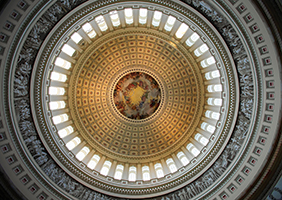Newsroom
SBA, Treasury update forgiveness, loan review IFRs
 The Small Business Administration (SBA) and the Treasury Department released revisions to two interim final rules (IFR) related to the paycheck protection program (PPP): One on loan forgiveness and the other on SBA loan review procedures. These revisions implement changes made by the recently enacted Paycheck Protection Program Flexibility Act (H.R. 7010) and include both the recently revised, borrower-friendly PPP loan forgiveness application and the new EZ version.
The Small Business Administration (SBA) and the Treasury Department released revisions to two interim final rules (IFR) related to the paycheck protection program (PPP): One on loan forgiveness and the other on SBA loan review procedures. These revisions implement changes made by the recently enacted Paycheck Protection Program Flexibility Act (H.R. 7010) and include both the recently revised, borrower-friendly PPP loan forgiveness application and the new EZ version.
Under the PPP Flexibility Act, small businesses have up to 24 weeks to use the loans and the deadline for rehiring workers would be extended from June 30 to the end of this year. The law also changed the requirement related to the portion of PPP loan forgivable amount that must be used toward payroll from 75 percent to 60 percent.
In addition, the EZ application requires fewer calculations and less documentation for eligible borrowers. Both applications allow borrowers to use the original 8-week covered period – if their loan was made before June 5 – or an extended 24-week covered period. The changes are designed to result in a more efficient process and make it easier for business to experience full forgiveness.
The revised IFRs allow borrowers to apply for loan forgiveness before the expiration of the covered period, so long as the PPP funds have been exhausted, and up to the maturity date. Waiting more than 10 months after the expiration of the covered period will exceed the deferment period and require borrowers to make loan payments until they apply for forgiveness.
The revisions to the IFRs supersede the previous de minimis exemption where a borrower’s forgiveness would not be reduced if an employee refused to come back to work after an offer of re-hire. This de minimis exemption will only be available for employers who offer to restore reduced hours and the employee refuses.
Further information is accessible on the SBA's and Treasury's websites. NAFCU will continue to monitor potential changes to the PPP and remain in contact with the SBA, Treasury Department, and Congress to ensure credit unions can lend effectively through the program. Access NAFCU's updated PPP FAQs here.
Share This
Related Resources
Add to Calendar 2024-06-26 14:00:00 2024-06-26 14:00:00 Gallagher Executive Compensation and Benefits Survey About the Webinar The webinar will share trends in executive pay increases, annual bonuses, and nonqualified benefit plans. Learn how to use the data charts as well as make this data actionable in order to improve your retention strategy. You’ll hear directly from the survey project manager on how to maximize the data points to gain a competitive edge in the market. Key findings on: Total compensation by asset size Nonqualified benefit plans Bonus targets and metrics Prerequisites Demographics Board expenses Watch On-Demand Web NAFCU digital@nafcu.org America/New_York public
Gallagher Executive Compensation and Benefits Survey
preferred partner
Gallagher
Webinar
Add to Calendar 2024-06-21 09:00:00 2024-06-21 09:00:00 2024 Mid-Year Fraud Review Listen On: Key Takeaways: [01:16] Check fraud continues to be rampant across the country. Card fraud is affecting everyone. [04:31] Counterfeit US passport cards are just another new toolbox in the bad actors’ toolbox. [07:21] Blocking the fallback is the only way to defeat counterfeit cards. [11:17] The best way is constant education to your members in as many channels as you can. [13:02] We are still seeing overdraft lawsuits. Make sure the programming you have at your credit union matches what you have displayed for the members. Web NAFCU digital@nafcu.org America/New_York public
2024 Mid-Year Fraud Review
Strategy & Growth, Consumer Lending
preferred partner
Allied Solutions
Podcast
Add to Calendar 2024-06-21 09:00:00 2024-06-21 09:00:00 The Evolving Role of the CISO in Credit Unions Listen On: Key Takeaways: [01:30] Being able to properly implement risk management decisions, especially in the cyber age we live in, is incredibly important so CISOs have a lot of challenges here. [02:27] Having a leader who can really communicate cyber risks and understand how ready that institution is to deal with cyber events is incredibly important. [05:36] We need to be talking about risk openly. We need to be documenting and really understanding what remediating risk looks like and how you do that strategically. [16:38] Governance, risk, compliance, and adherence to regulatory controls are all being looked at much more closely. You are also seeing other technology that is coming into the fold directly responsible for helping CISOs navigate those waters. [18:28] The reaction from the governing bodies is directly related to the needs of the position. They’re trying to help make sure that we are positioned in a way that gets us the most possibility of success, maturing our postures and protecting the institutions. Web NAFCU digital@nafcu.org America/New_York public
The Evolving Role of the CISO in Credit Unions
preferred partner
DefenseStorm
Podcast
Get daily updates.
Subscribe to NAFCU today.
